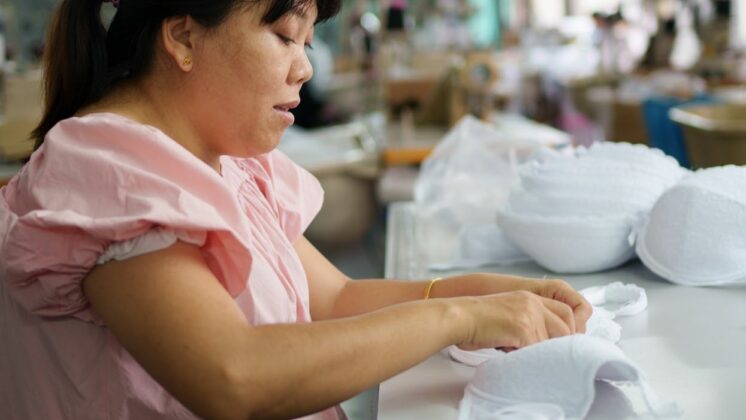The garment industry around the world is renowned for low wages, excessive overtime and poor working conditions. In many cases, even the legal minimum wages set for workers in the apparel industry fail to provide enough income to maintain a family of four above the nationally defined poverty level. For these reasons, union leaders and labour activists in Asia have come together to explore a strategy for workers in the global garment industry. Together they have come up with a way of establishing a floor on the race to the bottom and preventing wage competition between Asian garment-exporting countries. They are calling it the ‘Asia Floor Wage Campaign’. The Asia Floor Wage (AFW) is a demand for a minimum living wage, but one that can be standardised and compared between countries. it is based on the income required for a single earner to support a family of four (2 adults and 2 children) by working a legal maximum working week (but no longer than 48 hour), excluding any payment for overtime or other bonuses/allowances. It accounts for the cost of a fair amount of food per day, plus other essential living costs such as healthcare, housing, clothing, childcare, transportation, fuel, education, etc. By then expressing it in a single convertible sum - what they are calling ‘purchasing power parity in US$’ or PPP$ for short – a wage demand can be achieved that is applicable in each country and across borders. The Asia Floor Wage for 2009 was set at 475 PPP$.
The garment industry around the world is renowned for low wages, excessive overtime and poor working conditions. In many cases, even the legal minimum wages set for workers in the apparel industry fail to provide enough income to maintain a family of four above the nationally defined poverty level.
The consequences of poverty wages are most clearly seen in excessive working hours and disrupted family life. Poverty wages push many workers into debt, lead to malnutrition, cause health problems, and make workers and their dependents extremely vulnerable to unemployment, disability, and faster decline in old age. What is more, growing inequality within a country can reduce social cohesion and result in unrest.
Labour rights’ advocates have always argued that a minimum living wage is a cornerstone of decent working conditions, because sufficient wages are essential to workers’ well-being. Insufficient wages imply that individuals, families and communities who depend upon wage labour for their well-being cannot lead a dignified life. This demand is in line with the United Nations Universal Declaration of Human Rights. Article 23(3) states: “Everyone who works has the right to just and favourable remuneration ensuring for himself and his family an existence worthy of human dignity, and supplemented, if necessary, by other means of social protection.”
The International Labour Organisation (ILO), which is the United Nations’ body that sets labour standards, also endorses a living wage standard. The Preamble to the ILO Constitution notes that peace and harmony in the world require “the provision of an adequate living wage”. The ILO Constitution mentions the need to develop: “policies in regard to wages and earnings, hours and other conditions of work, designed to ensure a just share of the fruits of progress to all and a minimum living wage to all employed and in need of such protection.”
The reality of working conditions in the garment industry is far removed from the international goal of ‘decent work’ for all women and men in the world. ‘Decent work’ is the phrase used by the ILO, and it means the right of all to work in conditions of freedom, equity, security and human dignity. In the global garment industry of today, it is the brand-named companies and giant retailers who wield most power. They have profited hugely from outsourcing production to low-wage countries, capitalising on poverty wages and benefiting from weak enforcement of laws that govern wages, working conditions, and labour rights. What is more, workers’ efforts to increase their wages often lead garment brands and retailers to relocate production elsewhere. so workers are often afraid to fight for better wages for fear of losing their jobs.
For these reasons, union leaders and labour activists in Asia have come together to explore a strategy for workers in the global garment industry. Asia is a major hub for garment production in the global economy, accounting for 60% of global garment production, and employing millions of workers across the continent, most of whom are women.
The Asia Floor Wage Alliance brings together a wide range of labour organisations from India, Bangladesh, Cambodia, Indonesia, Sri Lanka, Thailand, China, and Hong Kong. Also involved are trade unions, labour NGOs, antisweatshop movements, solidarity groups, and scholars from Northern countries in Europe and the United States of America. Together we have come up with a way of establishing a floor on the race to the bottom and preventing wage competition between Asian garment-exporting countries. We are calling it the ‘Asia Floor Wage Campaign’. By uniting together and adopting a common Asia-wide bargaining strategy, garment workers and their representatives and supporters in Asia and the North can campaign for improved pay and conditions without the fear of causing job losses. Instead of workers competing with each other, pressing wages down even more, we have formulated a unified, regional demand, with a global echo, for a wage which is decent and fair. The Asia Floor Wage (AFW) is a demand for a minimum living wage, but one that can be standardised and compared between countries.
Details are provided of how we arrive at our AFW: it is based on the income required for a single earner to support a family of four (2 adults and 2 children) by working a legal maximum working week (but no longer than 48 hour), excluding any payment for overtime or other bonuses/allowances. It accounts for the cost of a fair amount of food per day, plus other essential living costs such as healthcare, housing, clothing, childcare, transportation, fuel, education, etc. By then expressing it in a single convertible sum - what we are calling ‘purchasing power parity in US$’ or PPP$ for short – we can achieve a wage demand that is applicable in each country and across borders. At the Campaign’s third international planning meeting in Hong Kong in October 2008, we took into account our countries’ different economies, politics, and debates, plus wage survey data collected from various Asian countries, and set the Asia Floor Wage for 2009 at 475 PPP$.
We believe that a common wage demand can bolster union organising, which in turn will help to achieve other gains. An Asia Floor Wage for the garment industry will help us fight poverty, develop economically with decent labour standards, and improve the lives of workers who are mostly women. The AFW proposal can contribute towards achieving a more sustainable global garment industry, and be a concrete way of implementing the ILO’s Decent Work Agenda.
The AFW Alliance will target major retailers and global brands to sign agreements committing them to incorporate the Floor Wage formula into their price negotiations with suppliers. These companies control the global garment production chain and have the capacity to deliver the Asia Floor Wage to workers. Meanwhile, Alliance members in producer countries will apply pressure on the major manufacturers to ensure that price increases they get from the brands and retailers with whom they have contracts are passed on to workers in the form of higher wages.
Click here to read full proposal.








